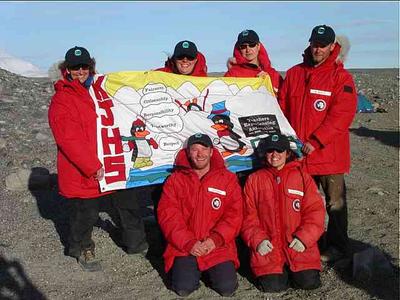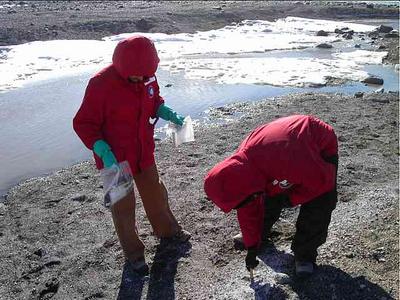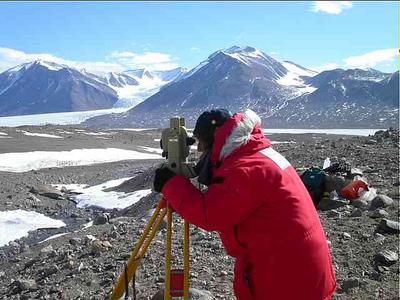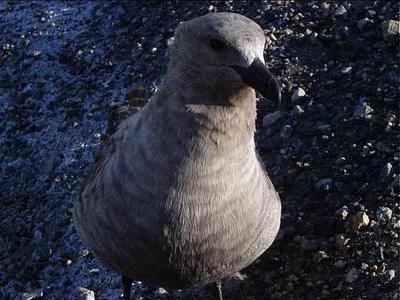3 January, 2003
Von Guerard Stream
Jen and I began to survey Von Guerard that runs alongside our
tents at about 1:00 this afternoon. We had a difficult time centering
and leveling "Theo", the surveying instrument. It took about 45
minutes, much longer than usual. Jeff, our surveying teacher in
McMurdo, says he sets it up in about two minutes! We've never taken
this long, but we've also never gotten close to two minutes. When we
finally started to survey, it was the most difficult job we have done
thus far because there were so many parts to survey. We had snow
patches, islands, algae mats, salt deposits, and a braided stream bed
of which all parts had to be marked with survey points. It took
several hours. It helped a lot to have Erin with us now. She was able
to take the water measurements and samples and the algal mat cores
while Jen and I plotted the course of the stream.
At about 5:30 everything changed. The flow in the stream increased
dramatically. Some of the islands we had just surveyed disappeared,
as did much of the snow cover. Field work can never be an exact
science because of the changing nature of eco-systems. Time,
temperature and water are essential and changing variables. We
started to see signs of life. A large piece of algae floated by,
looking very much alive. Several white areas, possibly made up of
clay, began spitting bubbles up. Could it be a sign of biological
processes? It is amazing how the addition of water brings forth life.
It's also amazing at how the smallest things that indicate life
interest us. There were five of us squatting near the water's edge to
stare at the little white bubbles that floated to the surface and
then got caught up in the stream flow. They looked like they had long
white tails. It might have been some of the clay or even a string of
smaller bubbles. Everyone shared ideas of what they could indicate.
Denitrification? Exchanges with the hyporheic, or wetted zone? We'd
like to believe we all have a scientific interest in their origin,
but John suggested that perhaps we were just deprived of TV for too
long!
Von Guerard (pronounced Von Gar' ah) has its origin in the glacier
behind our hut which John Gartner fondly refers to as "Gartner"
Glacier. It moves in a winding streambed downhill where it forms a
small delta as it flows into Lake Fryxell. Near our camp it splits
into lots of different channels that braid back and forth. The lower
part of Von Guerard is very flat and the wetted zones are wide.
Von Guerard stream measurement results:
pH = 6.5
Temperature = 7.5°C
Conductivity = 75.2 uS (micro siemens)
We will map the algal transects of the middle portion of the
streambed tomorrow. An algal transect is the area from which we take
our samples. They are mapped every three years, but because of last
year's record flows we are re-mapping them now to compare with the
past data. It is expected that we may see some dramatic changes.

1. The Stream Team outside F6 hut holding the KJHS
flag. (Front: John Gartner, Karen Cozzetto; Back: Louise Huffman, Jen
Baeseman, Erin Van Matre, Pete Spatz)

2. The "Yeast-ka-teers" with the KJHS flag. This
team is studying yeast and fungi and their roles in the soils of the
Dry Valleys. (We also call them the "Fun-guys" - - get it?!) We
invited them over for dinner from Lake Fryxell Camp across the lake
from our F6 camp. It's fun to get to know the other groups working
in the valleys.

 3.
Erin and Jen take algal mat cores at Von Guerard. Four cores are
taken from each site. Three are placed in plastic bags and mixed and
crushed with DI water (de-ionized) and then filtered. Those three
samples will be analyzed in this way: one will be examined at McMurdo
for chlorophyll A, another will be analyzed with an ash free dry mass
technique. The third will go back to Boulder, CO, for other
chlorophyll tests. The fourth sample is in a brown bottle to protect
it from the light. It will be looked at for structure and
identification purposes. 3.
Erin and Jen take algal mat cores at Von Guerard. Four cores are
taken from each site. Three are placed in plastic bags and mixed and
crushed with DI water (de-ionized) and then filtered. Those three
samples will be analyzed in this way: one will be examined at McMurdo
for chlorophyll A, another will be analyzed with an ash free dry mass
technique. The third will go back to Boulder, CO, for other
chlorophyll tests. The fourth sample is in a brown bottle to protect
it from the light. It will be looked at for structure and
identification purposes.
>

4. Me surveying Von Guerard with "Theo", the Total
Station.

5. A skua came right up to Erin and me while we were
taking algae samples. He was very bold and seems to know he is
protected by the Antarctic Treaty. He is allowed to approach us, but
we are not allowed to do anything to change his behavior. No "Shoos!"
are tolerated. He kept reaching his beak in to take the plastic bag
of samples from us! Because he's the largest, non-human life we see
in the Valleys, we find him pretty cute, as well as a nuisance! He
was less than a foot from the toe of my boot.
Contact the TEA in the field at
.
If you cannot connect through your browser, copy the
TEA's e-mail address in the "To:" line of
your favorite e-mail package.
|
